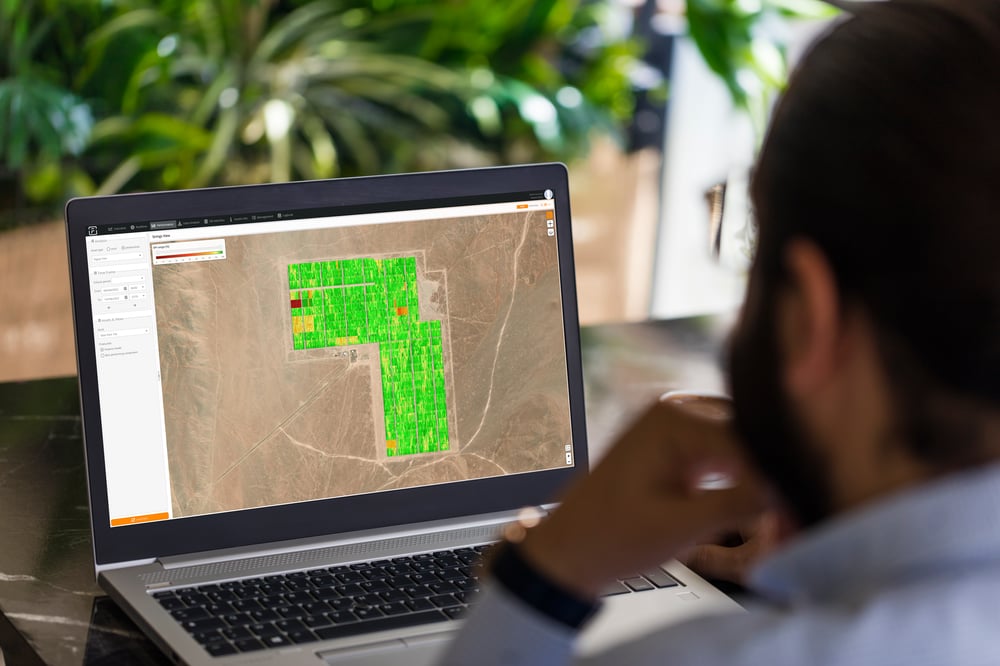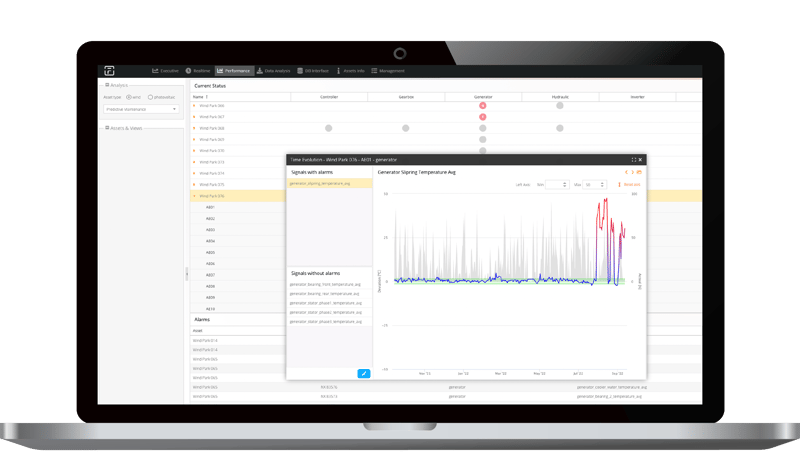Portfolios of grid-scale renewables and storage assets are growing rapidly, creating new challenges for owners and operators trying to maximize revenue while controlling costs. Today, challenges in data management, performance analysis, and issue identification often grow in lock step with scaling portfolios. Advanced, AI-powered APM tools, from analyzing the day-ahead power generation forecast of wind farms to identifying PV tracker alignment issues in a solar array, can maximize asset value even faster than portfolios grow.
 Between Two Electrodes is an educational series for energy professionals produced by Fluence with industry subject matter experts. This educational content helps our audience make better, more informed decisions on complex energy topics.
Between Two Electrodes is an educational series for energy professionals produced by Fluence with industry subject matter experts. This educational content helps our audience make better, more informed decisions on complex energy topics.
In this segment we cover the optimization of renewables and storage assets using asset performance management (APM) software with re:cap, a Swiss M&A advisor and asset manager for renewable energies; and Mario Kovacs, Platform Product Manager at Fluence.

Challenges of managing a diverse portfolio
Countries around the globe have recently announced or updated existing energy plans to bring even more solar, wind, and energy storage assets onto the grid.
In the Americas:
- The Inflation Reduction Act (IRA) was passed into law in August 2022 in the United States, setting forth ambitious plans for the power sector to reach zero carbon emissions by 2035.
- Chile has set out to become a renewable energy leader with the goal of converting 70% of its energy consumption to renewables by 2030, and has pledged to be carbon neutral by 2050.
Across Europe:
- Countries all over Europe have ambitious targets to support the RepowerEU plan (which you can learn more about in our last Between Two Electrodes post) to diversify and secure their energy supply.
- Italy plans to cut greenhouse gas emissions by 60% by 2030 and aims to deploy around 94.7 GWh of storage capacity by the end of the decade compared to around 1 GWh currently in place.
- Germany passed a series of laws in 2022 to expand the country’s clean energy focus, with a target for renewables to meet 80% of electricity demand by 2030.
In the Asia-Pacific region:
- Australia aims to increase the share of low-carbon power generation from 27% today to 82% by 2030, requiring a significant investment and build-out of renewables and storage assets.
- India is a high-potential market for renewables and energy storage with a goal of producing 500 GW of power from non-fossil fuel sources by 2030.
As covered in our recent blog article, this global growth in renewables and storage is bringing complexities in data management. Asset managers and owners with diverse portfolios, with assets across different technology classes, OEMs, and geographies, often scan disparate data sets across multiple systems to understand the performance status of their entire renewable energy portfolio. This is an inefficient use of time that does not scale well. It requires extensive training and knowledge to navigate different systems, aggregate data, and run comparative analyses.
In addition to this, data management is getting increasingly complex at the asset level. The new generation sources of today and tomorrow produce magnitudes greater data per asset. Solar produces approximately 5x more data than conventional generation assets, and storage assets may produce 100x more. Owners and operators of renewable and storage assets must wrangle with an avalanche of data points when trying to identify and act on asset performance issues.
Solving these data management challenges to efficiently manage diverse portfolios of assets is critical to hitting the global growth targets outlined above. In this video, our experts discuss how APM software tools help renewables and storage asset managers drive efficiency across diverse portfolios.
How can APM software help scale renewable portfolios?
APM software enables users to more efficiently monitor, analyze, and optimize the performance of their portfolios. It collects SCADA data in a single platform regardless of the asset type (wind, solar, storage, or hydro) and aggregates it with data from the transmission grid, prices from electricity markets, field service management systems, weather data, and more. In addition, it harmonizes this complex data across all assets and technologies.
The result is data-driven insights to analyze and optimize asset performance, helping operators identify and address issues faster, make asset downtime shorter, and manage risk better.
Artificial intelligence: Is it just a buzzword?
When it comes to APM software, AI-backed is the difference between a tool that lets asset managers see portfolio performance behind a single pane of glass, and one that makes inferences based on the data it collects. Broadly, AI enables APM software to analyze large amounts of data quickly, accurately, and automatically, then help users get more from their renewable assets with patterns it finds in their data.
Think of APM software like Fluence Nispera™ as a box with a set of many AI models, not a platform built on one AI. Fluence data scientists work with asset managers to identify the most pressing asset performance issues they face—turbine-bearing degradation, tracker misalignment of PV panels, HVAC malfunction in energy storage systems—and build an AI model for each, training each model on the data that most clearly is affected by that issue.

Nispera then uses signals from those models to create tools for getting the best performance from different assets, from customized alarms to automated reporting and more. Using AI, Nispera can identify patterns and anomalies that would be extremely difficult, often impossible, for analysts to identify manually. In the video below, we get into the specifics of how AI makes improving asset performance faster and more intuitive for renewable asset managers like re:cap.
Nispera includes multiple AI-backed tools, including predictive maintenance alarms, production forecasts, anomaly detection, and digital twins. At re:cap, asset managers use these tools to monitor performance issues in power plants, especially wind turbines.
For re:cap, Nispera’s AI-based tools pick up on power generation underperformance across their fleet of turbines and generate a warning, offering valuable insights into the underperformance. These insights include trends, visualizations, and statistics, enhancing the understanding of the factors contributing to the underperformance. Before this, analysts had to look at the power curve on each turbine to find anomalies. Re:cap also uses Nispera’s predictive maintenance alarms to anticipate bearing failure in wind turbines. Failed bearings can be very expensive depending on contract terms and lead times for spare parts. Knowing about them ahead of time allows re:cap to engage in proactive operations and maintenance planning, reducing downtime and saving money.
How does AI actually solve performance issues in renewable assets?
AI models can be extremely well equipped to find very specific root causes of performance issues. For example, using power generation data overlaid with time of day and sun position, Nispera’s AI-based tools can intuit that something was restricting the movement of a solar array quite easily and alert re:cap. Nispera’s AI models are even becoming nuanced enough to tease soiled panels apart from movement restriction issues, alerting users when their panels need to be cleaned.
However, there are still limitations to the power of APM software backed by these models. The availability of reliable data on the issues APM software is seeking to identify can pose a challenge. For example, while AI can pick up that a wind turbine is fractionally underproducing, it may still have a tough time deducing that the cause was a slightly incorrect blade angle. Unfixed, that blade would lead to significant energy losses over its lifetime and higher load on the drivetrain. In this video, our experts reflect on how difficult it often is to find the root cause of performance issues—for both analysts and APM software—how AI is helping today and where the most advanced AI-backed APM tools are headed in the future.
The causes of renewable asset failures are highly complex and compounded by the differences seen in each asset class. In turn, a single AI model cannot capture all of these nuances. Instead, the most advanced APM software are those that leverage a suite of AI models and a team of data scientists to constantly refine and craft new models, each trained to detect a particular issue (e.g. soiling of PV panels, tracking issues with PV arrays, pitch and yaw misalignment on turbines).
How can APM software be used to optimize energy storage technology?
The intermittency of renewable resources creates a challenge for asset managers in maintaining a consistent energy supply. Energy storage technologies are a powerful tool to mitigate this issue. But because storage and renewable assets serve distinct purposes, have different dynamics, and are operated differently, harmonizing all these technologies into one platform can pose challenges.
In this video, Mario highlights some of the added complexities involved in managing the performance of storage assets, as well as some of the unique benefits that come from those complexities. Also discussed is re:cap’s thinking on adding energy storage systems to their portfolio.
Energy storage systems have multicomponent hierarchical structures that create an abundance of data. This complex data can be hard to integrate but also presents big opportunities to develop more sophisticated data-driven models.
Which APM applications help optimize storage system operation?
Nispera utilizes AI to anticipate temperature-related performance issues in battery system components before they occur, predicting them days in advance. While SCADA alerts in battery storage systems are reactive, Nispera sends alarms with sufficient lead time, enabling proactive maintenance before any harm is inflicted on the system.

To mitigate the risk of warranty violations, Nispera also consistently monitors the operation of each asset, ensuring they remain within the specified contractual limits. This involves independent calculations based on various contractual parameters, enabling users to identify and investigate any disparities in calculated metrics.
What’s more, battery systems from different technology providers frequently employ distinct component hierarchies and utilize different SCADA systems, each with their unique signals and error codes.
Field technicians and asset managers can often have challenges in interpreting, analyzing, and acting on these diverse signals. Nispera works across battery and renewable technology providers and OEMs, translating and harmonizing those signals from all into actionable, clear alarms and historical analyses.
How to grow your asset portfolio without losing visibility
The rapid growth and increasing complexity of renewables and storage portfolios necessitates efficient, proactive, and incisive management. Asset managers can’t afford to be in the dark about the performance of their assets, regardless of their portfolio size. AI-backed APM tools like Nispera play a vital role in optimizing asset performance, reducing downtime, and saving costs. Combined, the strategic imperative for advanced APM software becomes clear for any renewable asset owner or manager in our evolving energy landscape.



















